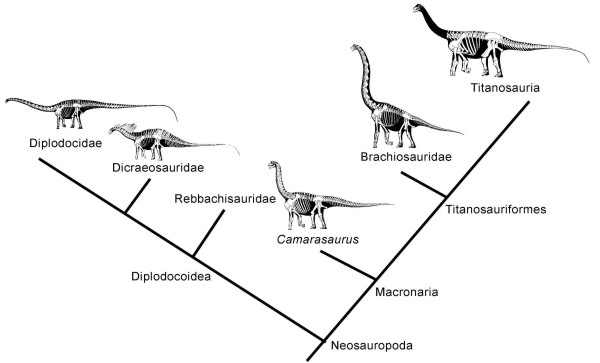
The most primitive known sauropodomorph is Saturnalia of the Late Triassic of Brazil. (Some fragments of other early sauropodomorphs from Madagascar might be as old as the Middle Triassic, but the age of the rocks they are from is not certain).
Basal sauropodomorphs are often called prosauropods. They may form a paraphyletic grade leading to the Sauropoda; they may form their own monophyletic group Prosauropoda; or there may be a combination of both.
Prosauropods are characterized by:
- Originally small size (1.5-2 m long), but eventually reaching 10 m or more
- Originally obligate bipeds, but as size increases they become facultative bipeds
- Retention of a big thumb claw and grasping hands
- Some prosauropods may have a beak, although this is uncertain
- Simple leaf-shaped teeth with no occlusion
- Only two or three sacrals: lower than almost all other dinosaur groups
- Prosauropods were the most common herbivorous dinosaurs from the Late Triassic to the Early Jurassic; no prosauropod survived into the Middle Jurassic, though
These three selective seem to have led to the evolution of the true Sauropoda. The oldest known sauropod is from the end of the Late Triassic, but sauropods do not become common until the Middle Jurassic.
Sauropods are characterized by:
- Extremely large size: all sauropods were at least elephant-sized as adults, and many much, much larger
- Obligate quadrupedality
- Reduced skull size
- Nares placed at least as high dorsally as the orbits
- Tooth-to-tooth occlusion for precise bites
- Extra cervical vertebrae
- Four or more sacrals
- Reduced number of phalanges on manus
Shunosaurus of the Middle Jurassic of China is a good example of an early sauropod. The giant size of sauropods would allow them to feed even higher in trees, digest more plants, and serve as defense against ever-larger predators. (Some sauropods developed additional defenses: Shunosaurus, for instance, had a tail club).
Different clades of sauropods had different solutions to tree-feeding:
Euhelopodidae is a clade of Middle Jurassic-Early Cretaceous sauropods from eastern
Asia. They had round fat bodies for support and many extra cervicals
to make their necks extremely long (the longest of any known animal).
The main sauropods of the Late Jurassic and the Cretaceous belong to the clade Neosauropoda. Neosauropods are characterized by:
- Column-like metacarpals
- Teeth concentrated at front of jaws

There are two main clades of neosauropods: Diplodocoidea and Macronaria.
Diplodocoids:
- Had long, sloping skulls
- Pencil-shaped teeth
- Nares are placed together above the orbits
- Tails ended in very narrow and long caudals
- Forelimbs much shorter than hindlimbs
- The recently-discovered Rebbachisauridae (Cretaceous of South America and Africa), with a dental battery similar to that in hadrosaurids (but only at the front of the jaws)
- Dicraeosauridae (Late Jurassic-Early Cretaceous of South America and Africa), with relatively short necks and very tall neural spines (forming fins or sails in Amargasaurus of the Early Cretaceous of Argentina)
- Diplodocidae (best known from the Late Jurassic of western North America), with:
- Very long necks
- May have reared up on hind legs to feed extremely high in trees
- Long, whip-like tails
- May have used these as defenses
- Known from several different genera, most importantly Diplodocus and Apatosaurus (formerly Brontosaurus)
- Very long necks
Macronarians ("big noses") are characterized by:
- Nares as large or larger than orbits
- Stout spoon-shaped teeth (although some titanosaurians have pencil-shaped teeth)
- Elongated metacarpals (almost half the length of the radius)
Camarasaurus of the Late Jurassic of western North America, Europe, and Africa is a typical primitive macronarian. The more advanced macronarians form Titanosauriformes, and are characterized by expanded snouts and nostrils placed on top of their skulls. Titanosauriforms include some of the largest dinosaurs (rivalled only by the largest diplodocids), and are divided into:
- Brachiosauridae, with forelimbs longer than hindlimbs
- Built uphill to reach high into trees without having to rear up
- Best known example is Brachiosaurus of the Late Jurassic of western North America and Africa; also, Maryland's State Dinosaur, Astrodon is a brachiosaurid
- Titanosauria, with extra wide hips and more flexible dorsal columns
- Were probably more agile than other sauropods, and may have been better at rearing
- Most common sauropods in the Cretaceous; were the main plant eaters until the end in most of the world
- Some forms had armored backs
- The largest known dinosaur, Argentinosaurus is a titanosaur
To Next Lecture.
To Previous Lecture.
To Syllabus.